Heidi Chiavaroli's Blog, page 10
October 17, 2017
Fighting Fear, Grasping Grace
The knock made me jump. I looked out the front door to see dark hair and a young face beneath a black-and-white baseball cap and the cold grip of fear seized my heart. I grabbed the phone and ushered my boys into their bedroom, far away from the door and that baseball cap.
It was Thursday, April 18, 2013, three days after the Boston Marathon bombing. Pictures of the brothers were all over the news, investigators searching for clues to where the two suspects could be—anywhere, it seemed, even my front door.
Despite my sons assuring me that they could “take the bad guy out” with their NERF guns, I called the police, and not long after, two officers crept into my backyard, guns drawn, searching my shed. They found no one and later tracked down a young tax assessor who admitted he had come to our house to check on renovation progress.
I felt foolish, and just a little crazy. Even after news stories finally stopped talking of the bombing, the feeling of fear didn’t go away. And this wasn’t anything new for me. After the events of the Sandy Hook tragedy just months earlier, I was living in fear and doubt and distrust and often, acute sadness for not only those in the tragedies, but for the state of the world. While I knew that anything could happen to me, my family, or my community, something about these two tragedies shook me up. Perhaps the fact that I was geographically sandwiched between them. Maybe because I had two children the same age as those at Sandy Hook. Or maybe that I was an avid long distance runner, that I had always dreamed of running the Boston Marathon. Yet whatever the reasons, I was a Christian, claiming to put my faith in a loving God. Why then, did I doubt Him? And how could I walk in faith while clinging to fear as my companion?
[image error]
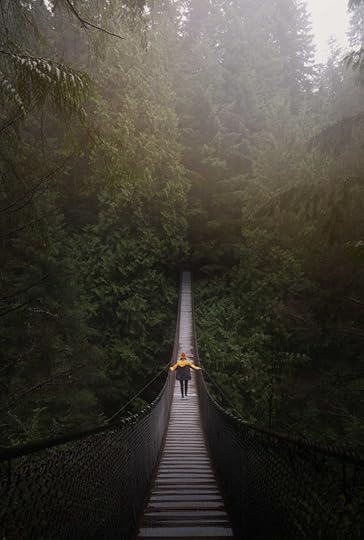
As I began my sixth manuscript attempt at publication, I didn’t set out to tackle this theme. What I did set out to do was distract myself and create what I hoped was a compelling story. This theme organically appeared in the story because it was something I was dealing with at the time.
In the process of answering the question of how I could conquer fear, two women—centuries apart—were birthed. Annie is a Boston Marathon bombing victim, wondering how she will ever get past the bombing, and the subsequent choices she has made to separate herself from her family, including a niece who lost a leg in the bombing. The ring given to Annie the day of the bombing becomes an idol to her. She looks to it for hope and strength. Liberty is a woman wondering how she will ever get past the death of her brother in the Boston Massacre, and the subsequent choices she has made in stealing a ring from a man (a British officer) who has shown her nothing but kindness.

Both women are bound with chains they were never meant to carry. Both women look to the ring and to themselves to find the strength they know they lack.
And through the journeys of these two fictitious women, along with some amazing books and Bible studies and encouragement of others, I began to breathe again, to glimpse the true freedom won for me long ago.
I hope it is one you are also reminded of as you journey with Annie and Liberty in Freedom’s Ring.
Subscribe to my RSS feed

Share this post
October 3, 2017
Why I Write The Difficult
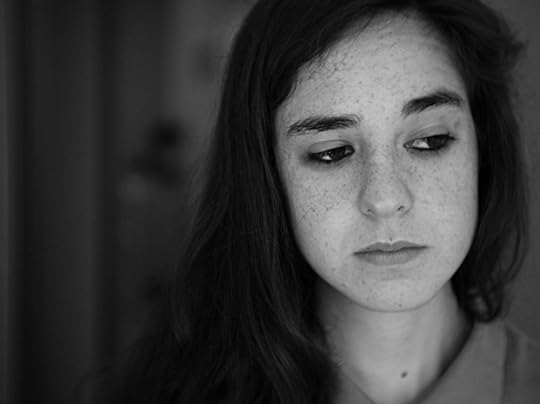
We woke yesterday morning to news of horrendous tragedy. Again, we utter prayers that plead for victims and families, to those who will forever be changed because of one man’s horrific actions.
Our responses are similar, I’m sure.
“How could this happen?”
“There are no words.”
“We are heartbroken, praying for those in Vegas.”
“What is happening to our world?”
As I watched Matt Lauer and Savannah Guthrie speak to a guest about the shooting, I think Savannah put words to what so many of us were thinking. She said no matter the security measures and efforts of so many safety workers, “if someone has evil in their hearts, [and is set to carry it out] it is often so hard to prevent it.”
Did you hear it? Evil, in this instance, has won. Circumstances were out of our control. This is what churns up fear in my life. It’s why I wrote a book with strong themes about overcoming fear. And yet, just when I think I’ve come to a deeper level of resting faith, a deeper understanding of how to conquer fear and evil and relinquish my need for control, I turn on my television to see another case where, it would seem, evil has won.
I want that control. That assurance that if I’m at the wheel, all will be well. Yet when we are faced with tragedies such as the one that occurred Sunday night, when we are faced with severe hurricane damage, when we are faced with news that someone we love has just Od’d, we are also faced with the reality that we really have no control at all.
Some people ask me why I write what I write. My books are not sweet and they are not fluffy. Yet they definitely carry a message that I feel is important. While I can appreciate a sweet romance, I am also acutely aware of the growing fear in the world in which we live. I work part-time at a pharmacy. I know just how many of us need anti-anxiety pills to make it through the day. I’m not judging—far from it. I get it.
I get that this is our reality right now. Struggling with what life brings. Captivated with things inside our computer screens or phones or televisions, immersed in the next tragedy. The world is telling us a message, and it’s not an easy one to hear.
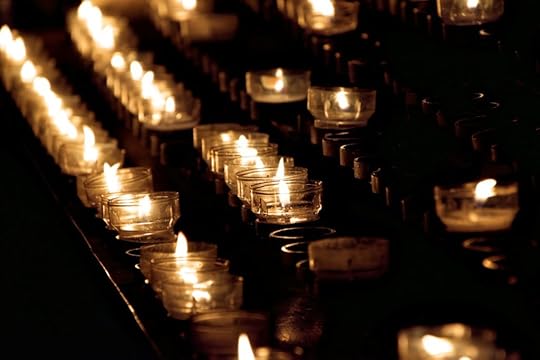
Things are not getting better.
Despite our technology, despite our comfortable homes and air-conditioned cars, it seems, in many ways, the world is going crazy. And if you blink—or turn on your television again—you will see it only seems to get worse.
More scary, perhaps, is what’s going on in my own heart. I am ashamed to admit that my heart is getting accustomed to this hard place. I am not quite so shocked to turn on the news and hear of the next tragedy. Yes, I shed my tears and utter heartfelt prayers for the victims, but something is lost as well. An innocence of sorts.

So why do I write about the difficult?
Not just to immerse myself in the lives of those who have walked this road of suffering, but for another reason as well. A reason that is so much larger and bigger than it’s simple, unassuming four letters.
Hope.
How many of us, beneath our newsfeeds and political leanings, beneath our broken families and addictions, beneath our medications and the mess of our own hearts (never mind the mess of those around us) need this hope? I know I do. In fact, I’m not sure I could begin to breathe one day without it.
The funny thing about hope and good news is that it shines more brightly even in the darkness. So when I write about a bombing or a historical war, when I write about the unspeakable actions of a family member or a heart torn apart by addiction and suffering, know that in part, it is what I relate to. It’s where despair tends to trip me up in this messy, broken world.
BUT there is hope. And that is where I choose to cling.
There will be a day when grace triumphs over all. When death and anger and hurting and fear and sadness are no more. Where victory is truer and sweeter because of the mess we’ve lived in.
I pray you are comforted by the following words, said by the God-man who brought that special four-letter word to the world over 2,000 years ago. He knew I’d need to hear these words now, today.
And I’m trusting He knew you might, as well.
“I have told you these things, so that in me you may have peace. In this world you will have trouble. But take heart! I have overcome the world.”
~ John 16:33
“Blessed are the poor in spirit,
for theirs is the kingdom of heaven.
Blessed are those who mourn,
for they will be comforted.
Blessed are the meek,
for they will inherit the earth.
Blessed are those who hunger and thirst for righteousness,
for they will be filled.
Blessed are the merciful,
for they will be shown mercy.
Blessed are the pure in heart,
for they will see God.
Blessed are the peacemakers,
for they will be called children of God.
Blessed are those who are persecuted because of righteousness,
for theirs is the kingdom of heaven.”
~ Matthew 5:3-10
Subscribe to my RSS feed

Share this post
September 19, 2017
America’s Oldest Time Capsule
In December 2014, construction workers at Boston’s State House uncovered America’s oldest known time capsule. A month later, the contents were revealed at the Museum of Fine Arts, almost 220 years after they were buried by Governor Samuel Adams, Paul Revere, and William Scollay on July 4, 1795.
Inside the capsule were some folded newspapers, coins (including a Pine Tree Shilling dating back to 1652), a metal depicting President George Washington, and a silver plaque believed to be engraved by Paul Revere.
The capsule was placed at the new State House (as opposed to the “Old” State House, where the Boston Massacre occurred) in a ceremony dedicating the new House to the principles our country was built upon.
In “Freedom’s Ring,” my historical heroine Liberty, who is acquainted with Governor Adams through her brother’s death in the Massacre, leaves a poem in this time capsule. Besides the antique ring featured in my novel, Liberty’s poem is one of the main connecting points between Liberty and Annie, my contemporary heroine. While I’m not a poet, I did enjoy writing the prose. Both my Mom, who is a gifted poet herself, and my editor, Caleb, helped me make it a bit more worthy for such an awesome privilege as (fictitiously, anyway) being placed in the Time Capsule.
Freedom’s Ring (The Poem)
Across the swell of seas
in the midst of church bells’ ring
you came to me.
Despised for the scarlet coat,
shadow of enemies at your throat,
you came to me.
Bitterness and betrayal won,
on that fifth of March the fight begun.
Sorrow and secrets I bore alone,
for guilt and remorse left unatoned.
The ring not mine but yours, I know;
untold grief was mine to sow.
My sins you chose to forget
in a final act of selflessness.
Come April on the Green,
You shed your blood. . .still scarlet.
I despise the color through and true.
I shall recall the symbol of love and strife
as long as God above may grant me life.
Forgive me for my blinded eyes,
freedom’s ring and colors lie.
You were not the enemy after all.
And when at heaven’s gates I call
I remember. . .
“Victory belongs to the one who is strong.”
I will cling to Him all the dark night long.
A burst of freedom within my heart,
the ring I stole…my guilt departs.
as church bells ring and freedom chimes,
I remember.
~Liberty Gregory, 1795
Subscribe to my RSS feed

Share this post
September 5, 2017
Book Launch Party!
As I’m scrambling to finish up edits for Book #2, I wanted to share with you some of the pictures from my book launch party for “Freedom’s Ring” that was held the other night. I was amazingly blessed and overwhelmed by the love and support of so many, and I am so happy to share a little bit of it with you!
Here’s a picture of my kiddos scoping out the refreshment table before our guests arrive. Yummy!


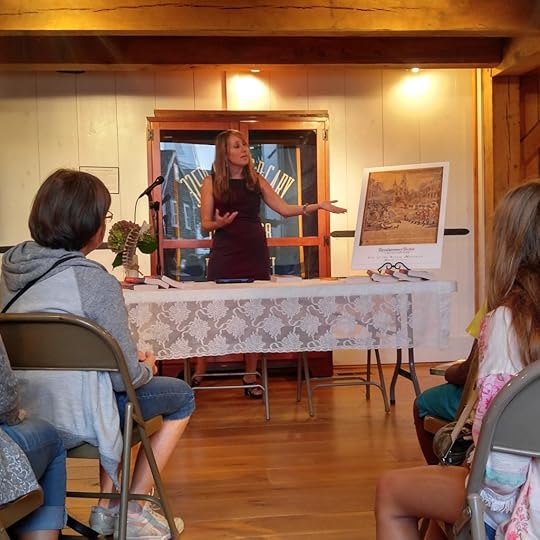
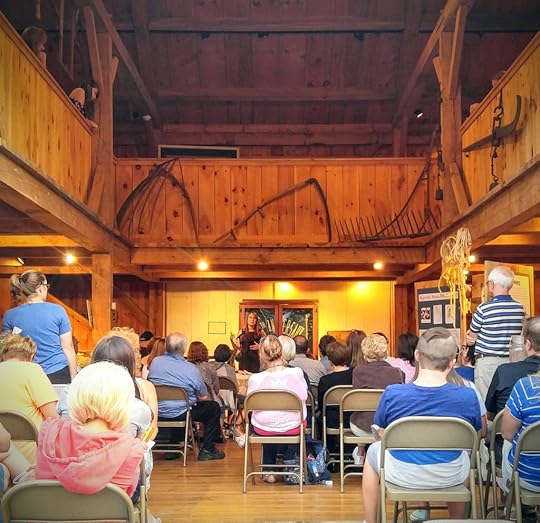
We were able to hold the party in a reconstructed 18th century barn complete with beautiful historical exhibits that included a weaving loom and weapons from the French and Indian war. So, so cool! I could not have imagined a more perfect venue.
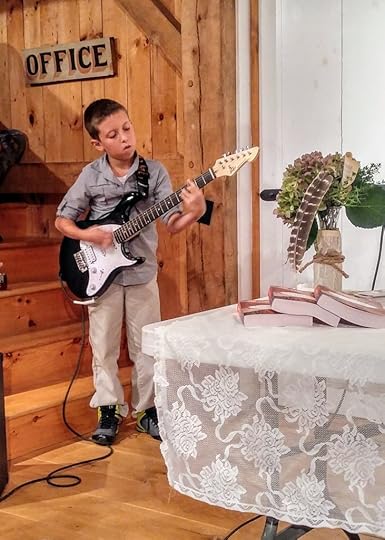
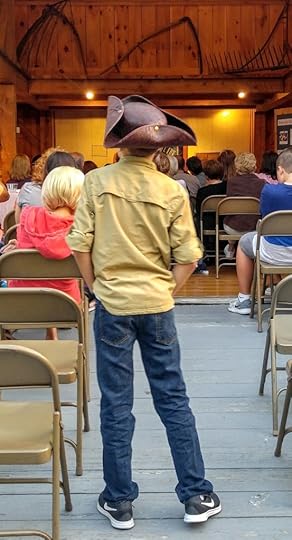

A beautiful night filled with beautiful people! I am so grateful!
Subscribe to my RSS feed

Share this post
August 8, 2017
Celebrating Release Day with a “Tour of Boston” Alongside Freedom’s Ring!
We’ll begin our tour here, at this important site in both history, and in “Freedom’s Ring.” The Old State House (called the Town House in colonial days) is over 300 years old. The Boston Massacre occurred right in front of it and the building can be seen in Paul Revere’s engraving of the event.
In July, 1776, the Declaration of Independence was first read from the balcony to the citizens of Boston. This tradition continues every Fourth of July.
To learn more, visit here.
IN THE BOOK:
Contemporary: Pages 25, 259-260
Historical: Pages 36, 62-69
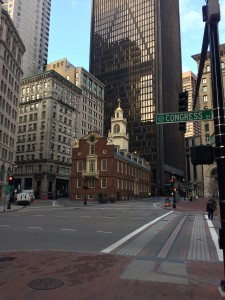 The Old State House
The Old State House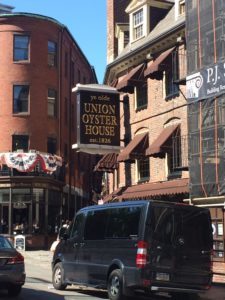 Union Oyster House
Union Oyster HouseUnion Oyster House
Although this place did not exist in colonial times, it is dear to my heart. Brad and Annie first meet here, and this is the place where I signed my contract! It was also the site of Isaiah Thomas’s “Massachusetts Spy,” a popular Patriot newspaper at the time. Midwife Louisa lives close to the present-day Union Oyster House.
If you’re in Boston, stop and have a meal here. Their food is fantastic. My kids are particularly fond of the corn bread and oyster crackers!
IN THE BOOK:
Contemporary: Pages 26-33
Historical (on Union Street): Pages 125-132, 147-152, 167-171
Old Granary Burying Ground
Very close to the Common and now beside Park Street Church, the Old Granary Burying Ground plays an important part in “Freedom’s Ring.”
It is named for a large grain storage building that used to be where the church is now located. Buried here are the five victims of the Boston Massacre and many of the fathers of our country, including Sam Adams, Paul Revere, John Hancock, James Otis, and Robert Treat Paine.
IN THE BOOK:
Contemporary: Pages 260-261
Historical: Pages 39-43, 104-106
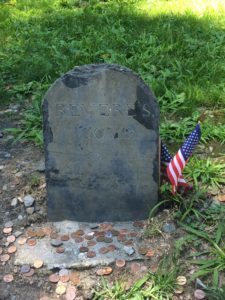 Paul Revere's Gravestone
Paul Revere's Gravestone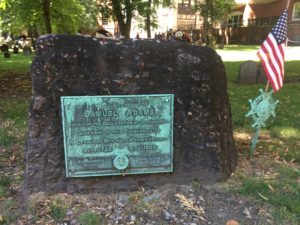 Samuel Adams's Gravestone
Samuel Adams's Gravestone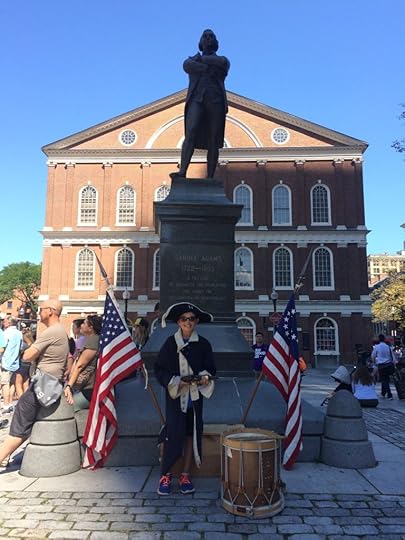 Faneuil Hall and Statue of Samuel Adams (with James dressed as Patriot)
Faneuil Hall and Statue of Samuel Adams (with James dressed as Patriot)Faneuil Hall
Nicknamed “The Cradle of Liberty,” Faneuil Hall was built in 1742. Both a meeting and market place, Sam Adams prodded the citizens of Boston to fight for their independence here.
IN THE BOOK:
Contemporary: Page 26
Historical: Page 78
Lexington Green
This is where the official start of the American Revolution occurred, where a ragtag group of Patriots chose to stand their ground against the King’s Army and fight for their freedom. I get chills just thinking about it!
I highly recommend coming to see the yearly reenactment put on by the Lexington Historical Society.
Learn more about this, and the following two Lexington sites here.
IN THE BOOK:
Contemporary: Pages 332, 335-336
Historical: Pages 295-300
 Lexington Militia
Lexington Militia The Old Belfry, Lexington, rang out the alarm that first Patriot's Day.
The Old Belfry, Lexington, rang out the alarm that first Patriot's Day.The Old Belfry
This belfry not only played an important part in history, it is an important symbol in my book. Located on Lexington Common the morning of April 19, 1775 (Patriots’ Day), the belfry was the first to summon the militia to fight for their freedom. Now located just to the side of the Common, this exact replica is rung every Patriots’ Day to signal the start of the Lexington Reenactment.
IN THE BOOK:
Contemporary: Pages 118-119
Historical: Pages 185, 285, 288, 293
Buckman Tavern
If you ever come to Lexington, be sure to take a tour of this historic place—one of my favorites! It was here that the militia gathered, waiting for the arrival of the Regulars that early April morning in 1775. Though I do not feature it in the contemporary part of “Freedom’s Ring,” it is such an important part of the historical story (and of history!), I couldn’t leave it out.
IN THE BOOK:
Historical: Pages 185, 191, 220, 248-253, 288, 300-303, 315-319
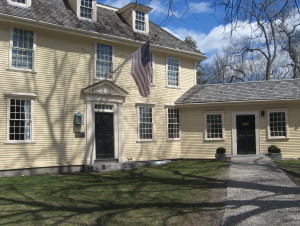 Buckman's Tavern, Lexington.
Buckman's Tavern, Lexington.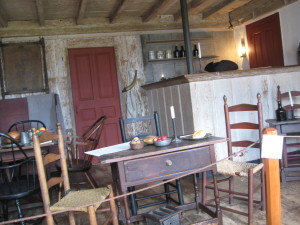 Inside Buckman's Tavern, where the Lexington militia waited for Regulars.
Inside Buckman's Tavern, where the Lexington militia waited for Regulars.Here ends the tour! I hope you’ve enjoyed it and I hope it gives you a better picture of the historical places and people that surround so much of the fiction in my debut novel, “Freedom’s Ring!”
**************************************************************************************************************
Subscribe to my RSS feed

Share this post
July 25, 2017
What’s In A Time-Slip Novel?
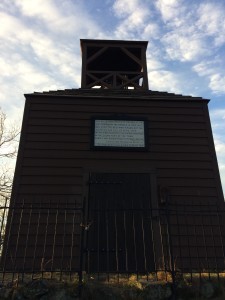 The Old Belfry, Lexington, rang out the alarm that first Patriots’ Day.
The Old Belfry, Lexington, rang out the alarm that first Patriots’ Day.Freedom’s Ring is a time-slip novel, which is a storytelling method that might be new to readers. When I tell potential readers that I write time-slip stories, many think time travel, but in the case of the stories I write, there is no time travel. It is not a fantasy or sci-fi thing—it is two stories—one contemporary, one historical—told alongside each other with an important means of connections throughout.
I’ve always been fascinated by Boston’s Revolutionary history and knew a story was waiting there for me. When the Boston Marathon bombing hit so close to home, it really shook me up. I realized around that time how much I was living in fear. So what does a writer do to work out her problems? She writes a book about them! I combined my love for a good historical story, grounded in another Boston tragedy almost 250 years earlier, and dove in with my characters, exploring the answer to my question, “How can I conquer fear?”
Along the way, I unearthed two characters, Annie and Liberty, who, though they live centuries apart, struggle with fear stemming from two different Boston tragedies. As I further explored the story, and even well into the writing, more and more similarities and connections came about. Here are two major ones in the story:
1) The first Boston Marathon was run on April 19, 1897, setting the precedent that the oldest continuously running marathon in America would be run on Patriots’ Day, a holiday commemorating the start of the American Revolution, recognized only in Massachusetts and Maine. While Liberty’s story begins at the Boston Massacre, she is involved at the original Patriots’ Day at Lexington, 1775. Bound by this event, this place, and their struggle to cast out fear and find true freedom in the midst of tragic events that, though far apart in time, share the thread of threatening our country, Annie and Liberty’s stories become entwined.
2) I was in the midst of a particularly rough writing day, struggling to make the two stories connect when my husband came home and said, “Hey, did you see that they uncovered a time capsule in the State House buried by Sam Adams and Paul Revere?”
What?!
It was too perfect. This was real life. Sam Adams and Paul Revere REALLY had left a time capsule for the future to find and it was REALLY uncovered now, in 2014. I knew it had to be part of the story. So while I fictionalized the poem found in the capsule, the capsule itself was real, and put on display at the Museum of Fine Arts in Boston early 2015.
If you’d like to learn more about the Boston State House Time Capsule, click here.
For me, there’s something special about writing a time slip story. A part of the journey is faith—trusting that the real and imagined will come together while I work to make it so. And when a reader tells me they are touched by the journey of the characters, that it echoed with their own experiences, I feel the story continues, the story grows, taking on a new dimension and living on in this period of time.
Subscribe to my RSS feed

Share this post
July 11, 2017
The Real James Caldwell (of the Boston Massacre)
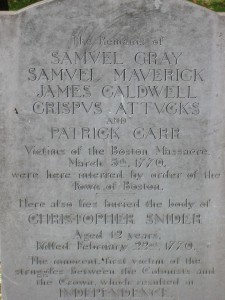 Gravestone of Victims of Boston Massacre
Gravestone of Victims of Boston MassacreSomething I love to do in historical fiction is to portray real historical people. I believe it adds an authentic element to my stories, and honestly, I’d find it strange to write about historical events without including the individuals who were so important to them! One of the people I took from history, but fictionalized in Freedom’s Ring, was that of James Caldwell.
We have surprisingly little historical knowledge of this victim of the Boston Massacre. He was a seventeen-year-old young man on a ship called the Hawk, commanded under Captain Thomas Morton. Records indicate he was not from Boston, since he had no family to take his body upon his demise in the Massacre. He was killed when two musket balls entered his back. Later records show a Luther Caldwell from New York claiming to be James’s ancestor.
As I began the manuscript, there were two things I changed about James’s history.
1) I made James a year younger.
2) I gave James a family—I gave him my historical heroine, Liberty Caldwell, as a sister.
It’s funny how these two small pieces of fictitious license can inspire a slew of “What if?” questions. What if James and Liberty’s parents died when they were young? What if James left Liberty with their grandmother to strike out at sea? What if that grandmother died? And what if Liberty went to Boston to reunite with James, her last living relative?
And so it goes until Liberty finds herself alone in a rebellious town, and after being briefly reunited with her Patriotic brother, she is torn from him again, this time in death, by way of the Boston Massacre.
His demise, and her complicated feelings for a red-coated Lieutenant propel the historical story forward…and into the American Revolution.
SaveSave
SaveSave
SaveSave
Subscribe to my RSS feed

Share this post
June 27, 2017
5 Things You May Not Know About the Boston Massacre
 Paul Revere’s Engraving of the Boston Massacre (Old State House in back).
Paul Revere’s Engraving of the Boston Massacre (Old State House in back).
The Boston Massacre, one of the major events that propelled our country toward seeking its independence from England, plays a major role in my novel, Freedom’s Ring. It occurred in Boston on the night of March 5, 1770. The conflict ended in the death of five colonists at the hands of the British Regulars, but because so many factors played into that night, and because so much was at stake for both the British and the Sons of Liberty from a political standpoint, fact and fiction have blended over the many years since the incident occurred. Here are some things you may not have known about the Boston Massacre.
1) The majority of British soldiers were miserable in Boston.
4,000 British troops came to Boston in October, 1768. They were charged with keeping order as the rebellious town of Boston (about 20,000) grumbled over the substantial taxation imposed upon it by the Townshend Acts.
The soldiers were not only despised by the locals, they were not paid well and were often forced to live in less than ideal circumstances. Many sought side jobs which further angered the colonists who were in need of the work themselves. Many of the soldiers were rude to the citizens and even engaged in street fights with boys of the town.
2) It wasn’t the first fatal incident in colonial Boston at the time of British occupation.
Not two weeks before the Massacre, a school boy of twelve years named Christopher Seider was killed in another dispute. He and some of his friends had been throwing rocks at the shop of a Loyalist merchant. Ebenezer Richardson, an unpopular Customs worker, came to the merchant’s defense. Richardson was hit in the head with a rock and ran to his home. The mob chased after him. Richardson shot his musket into the crowd from a second-story window, killing Seider.
Samuel Adams and the Sons of Liberty used Seider’s funeral as a display of political sentiment. Adams even called Seider “the first martyr to American liberty.” 5,000 Bostonians attended the memorial. The town was still reeling from this incident on the night of the Massacre.
3) The colonists started it.
The Massacre began when a young apprentice shouted out offensive comments to a sentry on duty at the Customs house on the night of March 5th. Words were exchanged before the sentry hit the boy with the end of his musket. The boy yelled for help and returned with a frenzied crowd of young men.
The sentry called for the main guard, led by Captain Thomas Preston. The crowd grew to 400 men who began throwing snow at the Regulars, pressing in on them with clubs, calling out lewd comments, and daring them to fire. Captain Preston’s trial account tells of a soldier getting hit with a stick, and then firing. Soon after, other soldiers followed suit, without having been given the order to do so.
4) Paul Revere’s Engraving Wasn’t Historically Accurate.
It might be hard to believe, but one of the most famous historical heroes of our country fudged his engraving of the event. In the most well-known image of the American Revolution, Paul Revere creates a piece of political propaganda that shows the most formidable army in the world being given orders to fire on an innocent crowd.
In the engraving, we don’t see the angry, working class colonists with their clubs. We see unarmed, well-dressed, gentlemen colonists on the ground, blood gushing from their wounds, a little puppy in the foreground for good measure.
Another notable fact is the absence of Crispus Attucks in the engraving. The first to fall that night, Attucks was a fugitive mulatto slave. Revere was clearly trying to gain the sympathies of his white, fellow peers across the thirteen colonies.
Not until 1856 (with the Civil War on the horizon) was a lithograph created showing Crispus Attucks at the center of the attack.
5) John Adams (yes, that John Adams) defended the British soldiers at trial.
While the second president of the United States and cousin to Patriot leader Samuel Adams empathized with the Patriots, he put his career and even his safety on the line to defend the Regular soldiers. One can only reflect on his motives, but many historians believe he chose to put the law above his own personal beliefs.
With John Adams and Josiah Quincy’s help, Captain Thomas Preston was found not guilty of murder.
Six of the remaining eight soldiers were also found not guilty of murder. The other two, Privates Kilroy and Montgomery were found guilty of manslaughter. Though the privates could have been sentenced to death for their crimes, they pleaded the “benefit of the clergy” and were spared. Originally used by clergymen, this ordinance allowed a religious member to claim they were outside the authority of the secular courts. It was eventually extended to first-time offenders. Both Privates Kilroy and Montgomery were granted the benefit, and branded with a letter “M” for “manslaughter” with a hot iron on their thumbs. Since offenders could only use the “benefit of the clergy” once, this would ensure they couldn’t claim it again.
So though five colonists lay dead as a result of the Boston Massacre, no real punishment was given to any of the Regulars. This fueled the fires of rebellion that would eventually lead to the Revolutionary War. It’s in these pages of history that the characters in my novel, Freedom’s Ring, find themselves.
SaveSave
SaveSave
SaveSave
SaveSave
Subscribe to my RSS feed

Share this post
June 12, 2017
Research for Freedom’s Ring
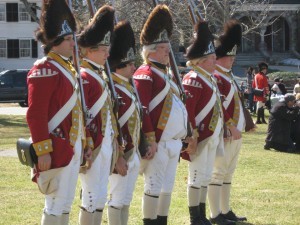
One of my favorite aspects of writing a novel is doing the research. If readers are trusting me with their time, I want to make every effort to deliver a book that is both enjoyable and accurate.I try to do as much work as I can prior to writing. It’s there that the ideas really start flowing, where inspiration is born from actual life—many times from past events.
I have always been drawn to Boston’s Revolutionary history and knew a story was waiting there for me. After learning more about the Boston Massacre and the complexity of the event, coupled with the fact of how well it paralleled my contemporary story which was based on events from the Boston Marathon bombing, I felt I could really dig into my research.
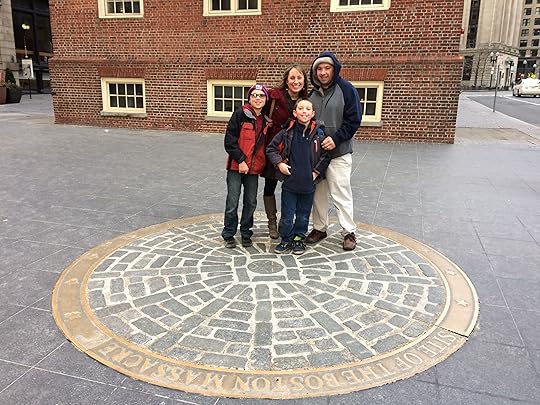

Before I began writing Freedom’s Ring, I read everything and anything I could get my hands on regarding Revolutionary Boston. This included both nonfiction and fiction, children’s and adult books. The poor librarians at my local library. Sometimes they’d have to give me my own shelf for all the books I placed on hold!
In addition to reading, I watched many History Channel and PBS documentaries, along with the spectacular HBO miniseries John Adams. These all helped me get a feel for colonial Boston.
Then I dragged my family to Lexington to see the reenactments, and then on to Boston and the Freedom Trail over and over again. I loved visiting the places I was writing about. All this history, practically right in my backyard. What a treasure!
Another special trip was to the New England Historical Genealogical Society in Boston. Before I visited, I took advantage of their amazing website, which holds tons of archived webinars and online learning programs—all extremely helpful as I constructed Brad and Annie’s search into the past. I had never done any genealogical searching myself, so I had a lot to learn!
When I visited NEHGS, I spoke to David Lambert, one of the chief genealogists at the society. He sparked an idea that really helped me connect the contemporary and historical stories in Freedom’s Ring.
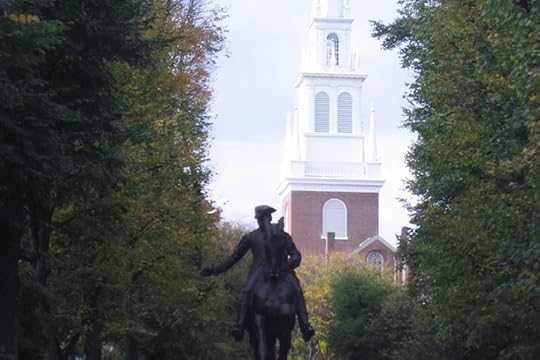
I spent at least three months researching for this book before I began the actual writing. By that time I was so steeped in Revolutionary Boston, I could better write from the view of Liberty, my historical heroine.
I loved every moment of this research and learning about the brave colonists who longed for independence. Freedom’s Ring releases August 8th and I can’t wait to share it with you!
If you’d like to check out some more of my research pictures, click the button below.
View More Images
Subscribe to my RSS feed

Share this post
May 29, 2017
The Excitement is Building!
Hello Dear Readers!
As release month draws closer, I thought it would be fun to blog more regularly about life, writing, and my debut novel, Freedom’s Ring. I look forward to giving you, my readers, some of the inside scoop into the work and research that has gone into this book!
And if you’re a Revolutionary War enthusiast, I hope you come back often so we can talk about some of the fascinating events that occurred in the making of our country. I’ll also be revealing more about the two women who play such a big part in this novel—Annie and Liberty. I have come to have a special relationship with these two and I can’t wait to introduce them to you all! They may live centuries apart, but they certainly have more than a ring in common to unite them.
We have a lot of exciting things we’re preparing as release month draws closer! I can’t wait to take you along with me to explore more of Boston’s amazing Freedom Trail. And if you’re a fan of contests—sit tight—we have some right around the corner.
Thank you to each and every one of you. This book would be nothing without you waiting for it on the other end.
Looking forward to the journey,
Heidi



